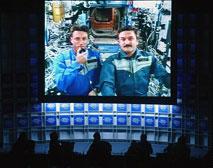A Russian supply ship took off on Thursday for the International Space Station, carrying equipment for research into the effect of radiation in space on manned missions to Mars.
Avi Blizovsky

Astronaut Michael Powell and cosmonaut Alexander Clary address the World Economic Forum in Davos last week from the International Space Station. Progress will bring them supplies
A Russian supply ship is on its way to the space station
A Russian supply ship took off on Thursday for the International Space Station, carrying equipment for research into the effect of radiation in space on manned missions to Mars.
The Progress M1-11 spacecraft took off on Thursday at 13:58 Israel time from the Baikonur Cosmodrome in the heart of the Kazakh steppe and is scheduled to dock at the space station today, Saturday.
"The spacecraft took off exactly on schedule and the flight is going well." A spokesman for the control center in Russia said. The ship contains two matryoshka dolls, Russian dolls that simulate humans in an experiment to measure the long-term effect of radiation on the astronauts. One of them will be attached to the outside of the space station and the other will transmit data to Earth while floating inside the shuttle. The researchers will chart the way to send humans to Mars - one of the tasks set by President Bush in his ambitious space program, which he announced in mid-January.
Remember, Russia is the only one serving the International Space Station since the Columbia disaster. This week, NASA repeated a statement according to which the shuttles could return to service in September 2004, but in light of Bush's plan, after the completion of the station's construction in 2010, the fleet will be retired.
Until the return of the shuttles, Russia will continue to serve the space station. It plans to launch a manned Soyuz spacecraft in April with a replacement crew for the current crew that was launched to the station in mid-October.
Yeast in space
Maggie McKee, New Scientist (translation: Dikla Oren)
A spoonful of yeast is included on the Progress payload, a Russian space vehicle that was launched on Thursday, which the International Space Station witnessed. The yeast is part of an experiment that will investigate the effects of microgravity on gene expression. In the long term, his goal is to investigate how human health can be protected in space.
The study began in 2002, but now its timing seems better than ever shortly after US President George W. Bush outlined an initiative that would focus the International Space Station on promoting manned space flights.
"Yeast is a model microbe," says Cheryl Nickerson, a microbiologist at Tulane University Health Sciences Center in Louisiana, USA, and one of the leaders of the study. "Their cell structure is very similar to the structure of the human cell, so we can use them to predict how humans will react to spaceflight."
Shemar has about 6400 genes. The researchers sent several different strains into space, each missing a certain gene. The yeast, which is now in a dormant state, will run on growth factor once they reach the International Space Station.
The yeast will grow for 72 hours, until one of the crew members of the International Space Station turns a crankshaft, which will stop the growth and preserve the yeast in a sort of frozen state. The experiment will probably return to Earth for analysis in April.
Back on Earth, the researchers will collect DNA from the yeast cells and put it on a DNA chip. The chip will identify which genes were active while the yeast was in orbit around the Earth. The comparison with control strains, left on Earth, will reveal the effect of low gravity.
A 72-hour experiment may not seem that relevant to a manned space flight - especially years-long flights such as the flights to Mars - but Shimmer is divided every two hours. The researchers were also promised the few months for future studies in the next missions to the International Space Station.
Previous studies, including research conducted by fellow researcher Tim Hammond of Tulane University and the VA Medical Center in New Orleans, Louisiana, show that microgravity may have a significant effect on gene expression.
Human kidney cells, grown in a space shuttle for six days in 1998 showed changes in the activity of 1600 genes out of about ten thousand. Compared to them, the activity of only about half of this number of genes changed in a low-gravity imaging facility on Earth, and the activity of only five genes changed in a laboratory dish on Earth.
The effect of microgravity on gene expression is unknown, but Hammond previously hypothesized that the effect originates from the similarity of the weightlessness to the environment in which the fetus is in the womb.
"Gravity may play an important role in regulating gene expression in all cells, and it may also play a central role in evolution," says microgravity researcher Stephen Moorman of the Robert Wood Johnson Medical School in New Jersey.
He says that gravity may have an indirect effect, by changing the concentration of metabolites in the cell's environment, or directly by giving small signals of force to the cell, which guide its development. "Flying yeast into space provides an opportunity to collect data, which may allow us to test these ideas," he told New Scientist.
Nickerson believes that her team's work is important, because it may shed light on the question of whether bacteria, "taking a ride" on a spacecraft, may become more violent due to changes in their gene expression.
Studies in microgravity imaging facilities on Earth have long shown that some disease agents, such as salmonella, may become more resistant to antibiotics, she says. As is known, flying in space weakens the immune system of the astronauts. "You can't keep an infection in isolation on a flight," she says.
